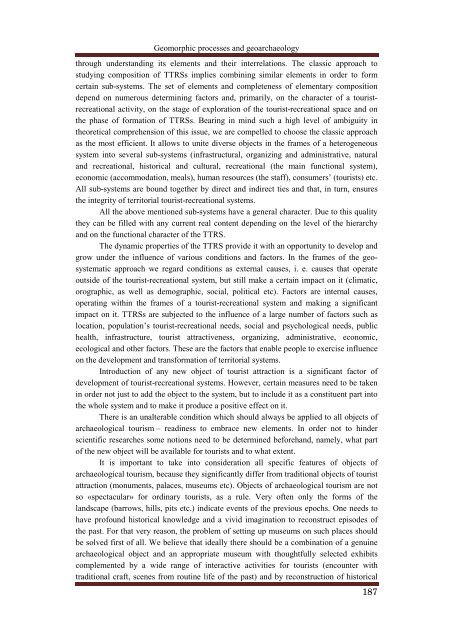extended abstracts - Geomorphic Processes and Geoarchaeology
extended abstracts - Geomorphic Processes and Geoarchaeology
extended abstracts - Geomorphic Processes and Geoarchaeology
You also want an ePaper? Increase the reach of your titles
YUMPU automatically turns print PDFs into web optimized ePapers that Google loves.
<strong>Geomorphic</strong> processes <strong>and</strong> geoarchaeology<br />
through underst<strong>and</strong>ing its elements <strong>and</strong> their interrelations. The classic approach to<br />
studying composition of TTRSs implies combining similar elements in order to form<br />
certain sub-systems. The set of elements <strong>and</strong> completeness of elementary composition<br />
depend on numerous determining factors <strong>and</strong>, primarily, on the character of a touristrecreational<br />
activity, on the stage of exploration of the tourist-recreational space <strong>and</strong> on<br />
the phase of formation of TTRSs. Bearing in mind such a high level of ambiguity in<br />
theoretical comprehension of this issue, we are compelled to choose the classic approach<br />
as the most efficient. It allows to unite diverse objects in the frames of a heterogeneous<br />
system into several sub-systems (infrastructural, organizing <strong>and</strong> administrative, natural<br />
<strong>and</strong> recreational, historical <strong>and</strong> cultural, recreational (the main functional system),<br />
economic (accommodation, meals), human resources (the staff), consumers’ (tourists) etc.<br />
All sub-systems are bound together by direct <strong>and</strong> indirect ties <strong>and</strong> that, in turn, ensures<br />
the integrity of territorial tourist-recreational systems.<br />
All the above mentioned sub-systems have a general character. Due to this quality<br />
they can be filled with any current real content depending on the level of the hierarchy<br />
<strong>and</strong> on the functional character of the TTRS.<br />
The dynamic properties of the TTRS provide it with an opportunity to develop <strong>and</strong><br />
grow under the influence of various conditions <strong>and</strong> factors. In the frames of the geosystematic<br />
approach we regard conditions as external causes, i. e. causes that operate<br />
outside of the tourist-recreational system, but still make a certain impact on it (climatic,<br />
orographic, as well as demographic, social, political etc). Factors are internal causes,<br />
operating within the frames of a tourist-recreational system <strong>and</strong> making a significant<br />
impact on it. TTRSs are subjected to the influence of a large number of factors such as<br />
location, population’s tourist-recreational needs, social <strong>and</strong> psychological needs, public<br />
health, infrastructure, tourist attractiveness, organizing, administrative, economic,<br />
ecological <strong>and</strong> other factors. These are the factors that enable people to exercise influence<br />
on the development <strong>and</strong> transformation of territorial systems.<br />
Introduction of any new object of tourist attraction is a significant factor of<br />
development of tourist-recreational systems. However, certain measures need to be taken<br />
in order not just to add the object to the system, but to include it as a constituent part into<br />
the whole system <strong>and</strong> to make it produce a positive effect on it.<br />
There is an unalterable condition which should always be applied to all objects of<br />
archaeological tourism – readiness to embrace new elements. In order not to hinder<br />
scientific researches some notions need to be determined beforeh<strong>and</strong>, namely, what part<br />
of the new object will be available for tourists <strong>and</strong> to what extent.<br />
It is important to take into consideration all specific features of objects of<br />
archaeological tourism, because they significantly differ from traditional objects of tourist<br />
attraction (monuments, palaces, museums etc). Objects of archaeological tourism are not<br />
so «spectacular» for ordinary tourists, as a rule. Very often only the forms of the<br />
l<strong>and</strong>scape (barrows, hills, pits etc.) indicate events of the previous epochs. One needs to<br />
have profound historical knowledge <strong>and</strong> a vivid imagination to reconstruct episodes of<br />
the past. For that very reason, the problem of setting up museums on such places should<br />
be solved first of all. We believe that ideally there should be a combination of a genuine<br />
archaeological object <strong>and</strong> an appropriate museum with thoughtfully selected exhibits<br />
complemented by a wide range of interactive activities for tourists (encounter with<br />
traditional craft, scenes from routine life of the past) <strong>and</strong> by reconstruction of historical<br />
187


